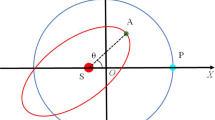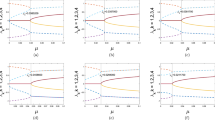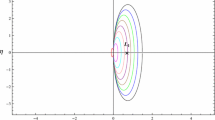Abstract
In this paper, the gravitational effect of a fourth body on the resonance orbit defined in the restricted three-body problem (RTBP) is considered. In this regard, Resonance Hamiltonian of the RTBP and the Hamiltonian associated with the fourth gravitational body that perturbs the resonance orbit are computed. The Melnikov approach is utilized as a mean for the detection of chaos in resonance orbit under the influence of the fourth gravitation body. In addition, the numerical simulation of RTBP and bicircular four-body model, time–frequency analysis (TFA), and fast Lyapunov indicator (FLI) are performed to verify the results of the Melnikov approach. The results indicate that for the (2:1) resonance orbit, the Melnikov integral computed over outer loop of separatrix does not cross the zero line, and consequently chaos is unexpected. On the other hand, the Melnikov integral computed over the inner sepratrix loop crosses the zero line indicating a potential for chaos. Similarly, it is shown that inclusion of the fourth body gravitation leads the (3:1) as well as the (4:1) resonance orbits to chaos. Additionally, simulation results indicate that for some initial conditions on the separatrix, the fourth body effect bounds the amplitude of the resonance orbits while diffusing its corresponding trajectory in the bounded phase space. TFA and the FLI verify similar results.












Similar content being viewed by others
Abbreviations
- \(a\) :
-
Semi-major axis
- \(e\) :
-
Eccentricity
- \(f\) :
-
True anomaly
- \(G\) :
-
Gravitational constant
- \(J\) :
-
Inclination
- \(L\) :
-
Mean anomaly
- \(M(t_0)\) :
-
Melnikov function
- \(m_i\) :
-
Mass of ith primary
- \(\omega \) :
-
Argument of perigee
- \(\Omega \) :
-
Longitude of ascending node
- \(P_j\) :
-
Legendre polynomial
- \(R\) :
-
Potential of third mass in
- \(r_2\) :
-
Distance relative to Earth
- \(r_3\) :
-
Moon position relative to Earth
- \(\psi \) :
-
True longitude
- \(\omega _g\) :
-
Frequency of periapse angle
- \(\omega _l\) :
-
Mean anomaly frequency
- \(s,s^{\prime }\) :
-
Parameters of resonance condition
References
Escribano, V.: Entitled Poincare section and resonance orbits in the restricted three-body problem. PhD Dissertation, Purdue University (2010)
Pourtakdoust, S.H., Fazelzadeh, S.A.: Chaotic analysis of nonlinear viscoelastic panel flutter in supersonic flow. J. Nonlinear Dyn. Chaos Eng Syst. 32(4), 387–404 (2003). Springer
Villac, B.F.: Using FLI maps for preliminary spacecraft trajectory design in multi-body environments. Celest. Mech. Dyn. Astron. 102, 29–48 (2008)
Vela-Arevalo, L.V., Marsden, J.: Time–frequency analysis of the restricted three-body problem: transport and resonance transitions. Class. Quantum Grav. 21, S351–S375 (2004)
Chirikov, B.: A universal instability of many-dimensional oscillator system. Phys. Rep. 52(5), 263–379 (1979)
Wisdom, J.: The resonance overlap criterion and the onset of stochastic behavior in the restricted three-body problem. Astron. J. 85(8), 1122–1133 (1980)
Assadian, N., Pourtakdoust, S.H.: On the quasi-equilibrium of the bielliptic four-body problem with non-coplanar motion of primaries. Acta Astronutica 66, 45–58 (2010)
Vela-Arevalo, L.V.: Time–frequency analysis based on wavelets for Hamiltonian systems. PhD Dissertation, California Institute of Technology (2002)
Stephen, L.: Dynamical System with Applications using Maple. Birkhauser, Boston (2010)
Celletti, A.: Stability and Chaos in Celestial Mechanics. Springer, Chichester (2010)
Brouwer, D., Clemence, G.M.: Method of Celestial Mechanics. Academic Press, New York (1961)
Argyris, J., Faust, G., Haase, M.: An Expolration of Chaos. North-Holland, Amsterdam (1994)
Spencer, D.: The gravitational influence of a fourth body on periodic orbit. MS Thesis, Purdue University (1985)
Author information
Authors and Affiliations
Corresponding author
Appendix
Appendix
Utilizing Newton’s gravitational law, one obtains that the motion of \(P_1\) and \(P_4\) in an inertial frame \((\xi _1, \xi _2)\) is described by the following equations:
Defining the Earth centric frame (\(P_1\)), the following relative distance are defined:
Thus, the equation of motion for \(P_4\) will be
where
Subsequently, (30) can be rewritten as
where \(\gamma = \frac{gm_3}{R_s^3}\)
It can be shown that the perturbation terms in the RHS of (31) can be simplified as,
Finally, the equation of motion and the Hamiltonian of the negligible mass (P4) in the bicircular model will be
where
One can also express \(R_2\) in terms of the resonance variables. Note that \(R_2\) can also be defined as posed in Eq. (3),
where \(S_2\) is the angle between Earth–Satellite and Earth–Sun vectors, see Fig. 13. Similarly \(\cos S_2\) can be defined:
Substitution of (37) into (36) with expansion of the trigonometric parts in terms of the Delaunay variables will result in the perturbation Hamiltonian \(R_2\) in terms of resonance variables. In Eq. (38), the Hamiltonian associated with the fourth body mass is shown, assuming a zero inclination orbit:
Expressing orbital parameters using Delaunay variables and assuming zero eccentricity for the Sun’s orbit and equating higher orders of \(\Phi \) and \(\Psi \) to zero will yield (39).
Rights and permissions
About this article
Cite this article
Pourtakdoust, S.H., Sayanjali, M. Fourth body gravitation effect on the resonance orbit characteristics of the restricted three-body problem. Nonlinear Dyn 76, 955–972 (2014). https://doi.org/10.1007/s11071-013-1180-5
Received:
Accepted:
Published:
Issue Date:
DOI: https://doi.org/10.1007/s11071-013-1180-5





